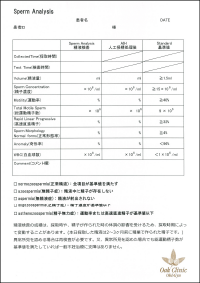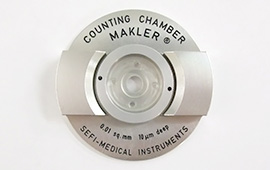At Oak Clinic’s Male Infertility Clinic, we are doing many things such as questionnaires, inspections, palpations, semen tests and hormone tests.
Questionnaires
In regards to past illnesses and present sexual activities, also we will confirm to see that there are not any conditions such as Erectile Dysfunction (ED) or a sexless condition.
Inspection / Palpation
We will check the testicular capacity by use of the orchidometer (testicular model made from plastic) and ultrasound, and we will check for palpable epididymitis and varicoceles.
Semen Test
We will collect the semen (we will collect the sample by means of masturbation), and then check for the number of sperm and the rate of motility.
Semen Reference Value (Issued by the WHO in 2021)
|
Volume of Semen
|
1.4ml or greater
|
|
Concentration of Sperm
|
At least 16 million per 1 ml
|
|
Motility rate
|
42% or greater
|
|
Total motile sperm count
|
9.4 million
|
|
Progressive
|
30% or greater
|
|
Normal morphology
|
4% or greater
|
|
Abnormal/Malformation rate
|
96% or less
|
|
White blood cell count
|
Less than 1 million per 1 ml
|
Sperm Test Findings
The results of the semen test will be filled in and returned.
Makler Counting Chamber
This is used to examine the concentration of sperm and its motility.
If the amount of semen is little or none when the test is performed, urine will be collected shortly afterward to check if sperm is flowing back into the bladder.
If this is the case, Retrograde Ejaculation can be diagnosed.
Blood tests can be performed to measure the amount of androgen (free testosterone), follicle-stimulating hormone (FSH), luteinizing hormone (LH), prolactin (PRL), etc.
When testicular sperm production is abnormal, testosterone in the blood decreases and FSH and LH increase. Abnormal FSH levels may show sperm dysfunction, and high PRL levels may show hypothalamic or pituitary disorders.







